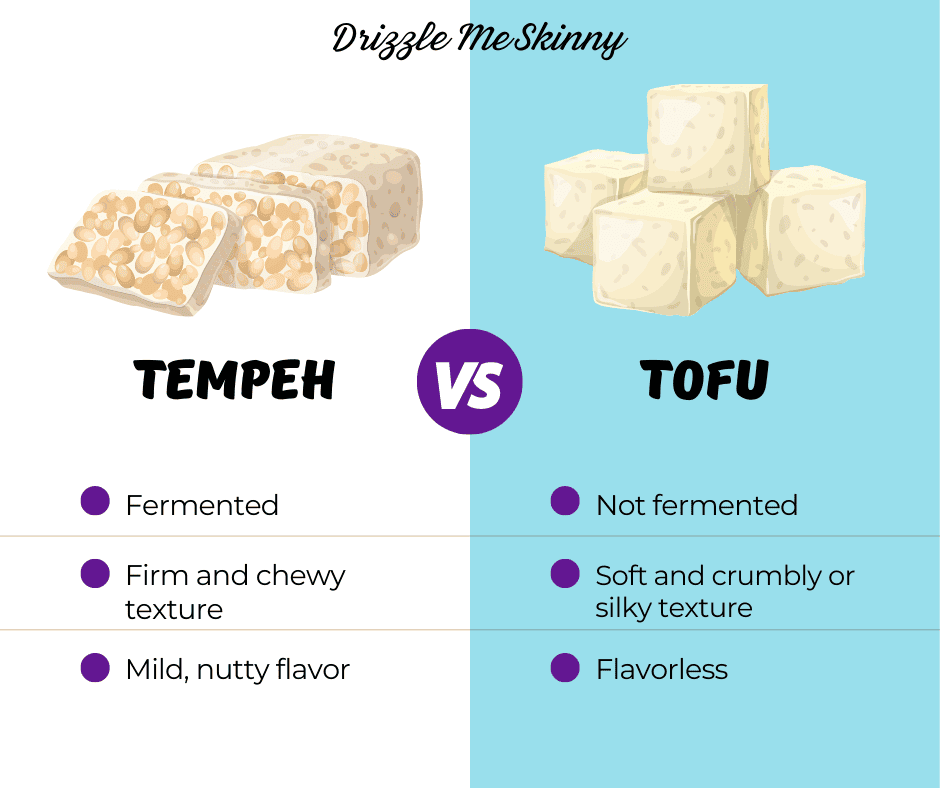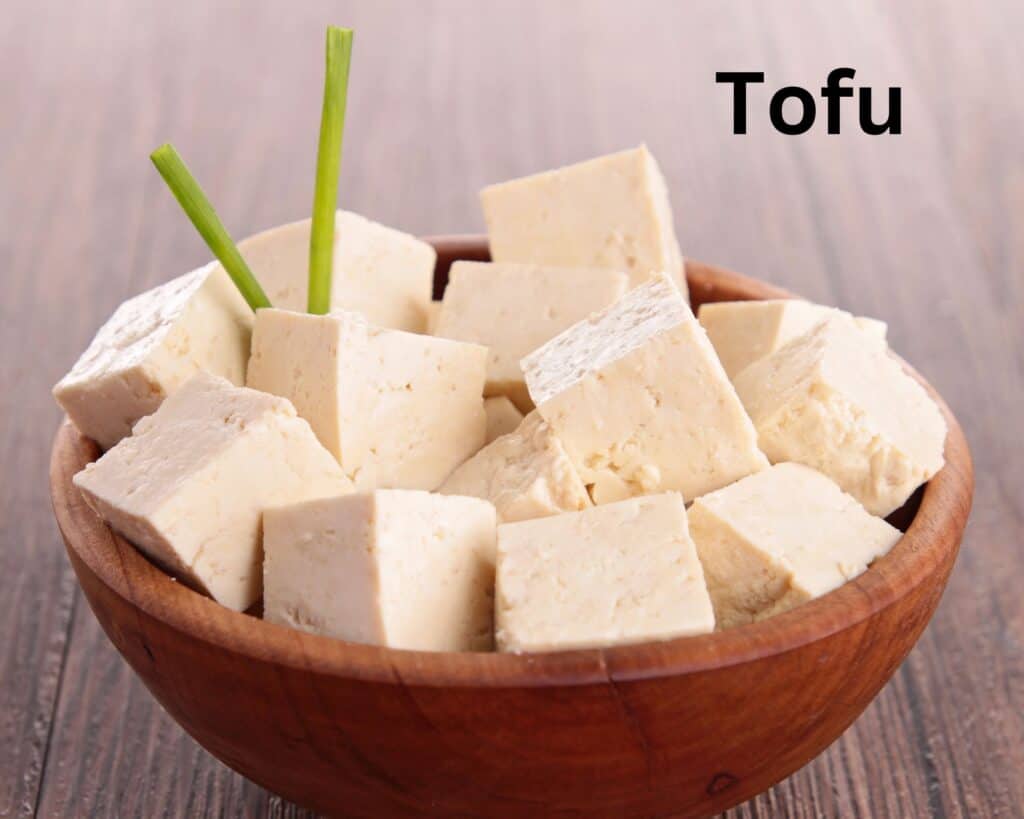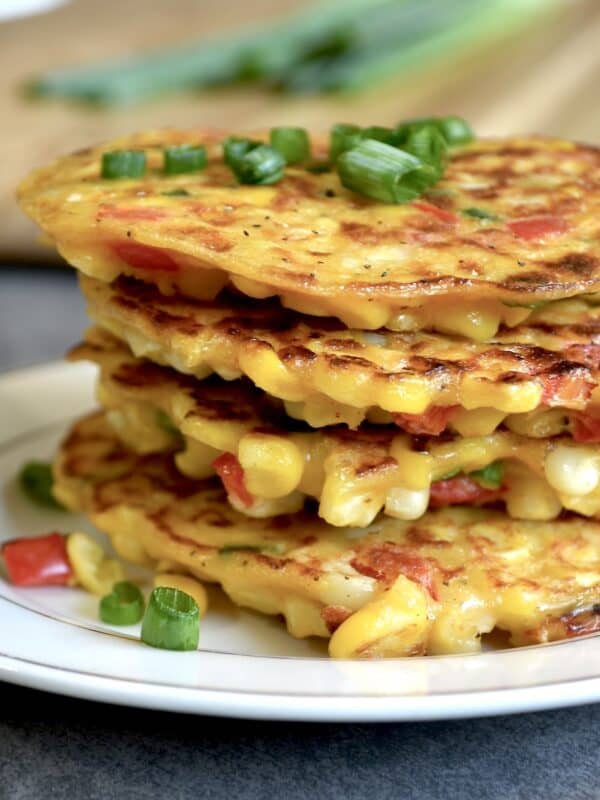If you’re looking to cut back on meat or simply want to add some new proteins to your diet, tempeh and tofu are two great vegetarian-friendly options. Both of these soy-based superfoods are incredibly nutritious and versatile in both flavor and texture.
In this article, we compare tofu vs tempeh and dive into what they’re made of and how you can incorporate them into your favorite meals, from stir-fries to salads and even desserts. Be sure to check out our favorite recipe recommendations, too!

What is tofu?
Tofu is a plant-based protein source derived from soybeans (soya beans) that is a staple in Asian cuisines. Tofu is white in color and is typically sold in block form. With a mild flavor and soft texture that takes on the taste of the sauces and broths it’s cooked in. Tofu is an incredibly versatile ingredient that is used in both sweet and savory recipes.
What is tofu made of?
Tofu is made from mature white soybeans that are ground and boiled in water to make soy milk. A coagulant, such as calcium or magnesium chloride, is then added and the milk is heated and pressed into a cheese-like block of soy milk.
The amount of time a block of tofu is pressed will determine the type of tofu being made. The longer a block is pressed, the firmer and dryer it will be. There are four main types of tofu: Soft, silken, medium, and firm/extra firm.

Types of tofu
- Soft tofu is pressed for a short time, just enough for it to hold its form. Soft tofu has a lighter, creamier texture than firmer tofu. The flavor is mild and milky.
- Silken tofu is made with soy milk that is thickened without curdling. This delicate tofu is often blended into creamy recipes, both savory and sweet. It can also be used as an egg substitute.
- Medium-firm tofu is pressed longer than soft tofu and is thus firmer and rougher in texture. Curds are visible in the block and it has moderate moisture content.
- Firm/extra firm tofu is pressed for the longest period of time and is the most resistant to handling. It also has much less liquid so it cooks up quicker than softer varieties.
Is tofu fermented?
Unlike tempeh, tofu is not a fermented food.
Breakdown of tofu nutrition
So, is tofu healthy? The verdict is: yes! Tofu is low in calories yet has 21.8 grams of protein per half-cup serving. Tofu contains all essential amino acids (a complete protein) and is rich in minerals and vitamins, including calcium, iron, potassium, selenium, magnesium, manganese, and vitamin A (source).
Tofu is also a great source of flavonoids, a compound produced by plants that may protect against heart disease and cancers.
How to cook tofu
Tofu can be prepared in so many ways! Because it is cooked during processing you can even eat it “raw,” although it doesn’t have much flavor on its own. To remedy this, tofu is often pressed (to release excess moisture) and then marinated before cooking.
Tofu can be breaded and baked, pan-fried, stir-fried, air-fried, deep-fried, or grilled. It can be cut into strips, cubes, or broken down into a “scrambled egg” texture. Silken tofu especially can also be blended into soups and stews, sauces, or even creamy desserts.
What to serve with tofu?
Because tofu takes on the flavors of the sauces and foods it’s cooked with, it pairs well with basically anything. To make a complete, balanced meal, pair this protein with grains (such as rice, quinoa, or noodles/pasta) and vegetables.
Tofu is often used in Asian cooking and thus is commonly served with aromatic sauces like soy sauce, hoisin sauce, and ginger chili sauce, to name a few.
Great tofu recipes
Ready to give this heart-healthy protein a try? This tofu tikka masala recipe is a versatile and nutritious dish that uses flavorful spices and creamy tomato-based sauce. From carnivores to vegans, the whole family will love it!
For more exciting tofu ideas, from creamy pastas and stir-fries to fudgy brownies and smoothies, be sure to check out these 25 amazing silken tofu recipes!

What is tempeh?
Like tofu, tempeh is a plant-based meat substitute derived from whole soybeans that are compressed into a flat, rectangular block. Tempeh has a nutty flavor that while still mild is a stronger flavor than tofu has.
What is tempeh made of?
Tempeh is made using whole soybeans. It can also include seeds or grains such as millet, wheat, flax seeds, quinoa, rice, or barley. For this reason, you should always double-check that your brand is gluten-free if necessary.
Whole soybeans are soaked to soften them before being cooked and going through a fermentation process. Finally, the fermented beans and other grains (if used) are pressed and formed into a firm block.
Is tempeh fermented?
Yes, tempeh is a fermented food.
Is tempeh healthy?
Tempeh has similar nutrition to tofu: high in protein, vitamins, and minerals but low in sodium and carbohydrates. Due to its strong nutritional profile, tempeh may help lower cholesterol levels and oxidative stress while improving bone health (source).
While tempeh is generally healthy, those with gluten intolerance should make sure the brand they use is free of wheat gluten. Be aware that many flavored versions of tempeh are high in sugar, salt, and other additives.
How to cook tempeh
Like tofu, tempeh is technically a cooked food because the soya beans are heated during processing. Therefore, you can enjoy tempeh without cooking it. But it doesn’t have much flavor on its own, so it’s a good idea to marinate it and/or serve it with a sauce. Some say that light steaming the tempeh before marinating helps to remove any bitterness.
After marinating, you can eat the tempeh as is, or cook it further. Common cooking methods for tempeh include baking in the oven or sautéeing in a pan. For maximum probiotic benefits, make sure the internal temperature doesn’t exceed 115 degrees.
What to serve with tempeh?
Tempeh is very enjoyable in a stir-fry with other vegetables, in salads, on sandwiches, in a Buddha bowl, or on its own. Similar to tofu, it pairs really well with grains (like rice or quinoa) and vegetables.
For maximum flavor, try pairing it with dipping sauces, such as soy sauce, peanut sauce, or salad dressing.
Great tempeh recipes
Now that you know how versatile tempeh is, try adding it to a vegetarian soft taco or delicious vegan burrito—two of my favorite ways to enjoy this protein! Or swap out the seitan for tempeh in this mouthwatering spicy buffalo wings recipe!
Summary: What is the difference between tofu and tempeh?
While both are vegetarian-friendly soy products, there are some key differences to note when comparing tofu vs tempeh:
- Fermentation: Tempeh is a fermented soy product while tofu is not.
- Texture: Because tempeh is made with whole soybeans, tempeh is much firmer and chewier than even firm tofu.
- Flavor: Tempeh has a mild, nutty flavor while tofu is practically flavorless. Both absorb the taste of marinades and sauces well.
- Nutrition: While both have similar nutritional profiles, tempeh contains more fiber and protein than tofu because it contains whole soybean vs just the milk.
Related Recipes
Looking for more ways to enjoy plant-based proteins? You’re going to want to give these vegan chicken nuggets a try! Made with heart-healthy oats and packed with veggies, these nuggets are a much healthier choice than store-bought vegan alternatives. And they’re simply delicious!
Frequently Asked Questions (FAQs)
Which is healthier tofu or tempeh?
Tempeh and tofu are both full of nutrients. Tempeh provides more protein, fiber, iron, and potassium per serving, while tofu contains more calcium and is lower in calories.
Is tempeh easier to digest than tofu?
Because it’s fermented, tempeh is easier to digest than its non-fermented non-fermented counterpart, tofu. A good source of probiotics, tempeh can also support gut health and improve digestion.
Can I eat tofu and tempeh everyday?
While generally healthy, eating too much tofu or tempeh can cause excess uric acid, which in some cases may lead to gout. Because they contain isoflavones (plant compounds that mimic estrogen), daily consumption is not recommended as it may affect the function of sexual organs in women.
Tofu vs Tempeh

Ingredients
Instructions
- Select your favorite recipe
- click the link to view the instructions
- follow linked instructions
- Enjoy!





